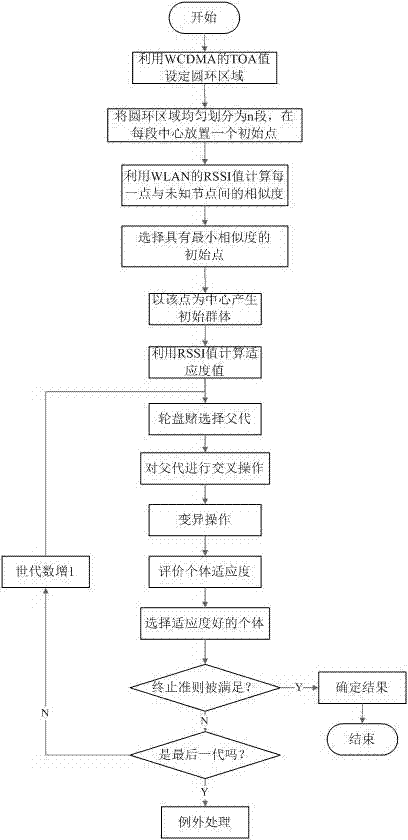Genetic positioning algorithm under environment of single-base-station heterogeneous network
A base station and algorithm technology, applied in the field of heterogeneous networks, can solve the problems of not making full use of heterogeneous network information
- Summary
- Abstract
- Description
- Claims
- Application Information
AI Technical Summary
Problems solved by technology
Method used
Image
Examples
Embodiment Construction
[0023] Input: WLAN network beacon node coordinates and RSSI values between unknown nodes, WCDMA base station coordinates and TOA ranging to unknown nodes.
[0024] Output: The coordinates of unknown nodes to be located in the heterogeneous network.
[0025] step:
[0026] Step1. Based on the TOA ranging value from the unknown node to the WCDMA base station , choose the inner ring radius as , the outer ring radius is The circular area of , and the circular area is evenly divided into n part;
[0027] Step2. Place an initial point at the center of each segment given in Step1, and getn an initial point; use each point to calculate the similarity between the theoretical RSSI value of each WLAN beacon and the measured RSSI value of the unknown node;
[0028] Step3. Select the ring segment where the minimum similarity node is located as the initial area, and distribute it randomly and uniformly in this area sample points as the initial population of the genetic algorit...
PUM
 Login to View More
Login to View More Abstract
Description
Claims
Application Information
 Login to View More
Login to View More - R&D
- Intellectual Property
- Life Sciences
- Materials
- Tech Scout
- Unparalleled Data Quality
- Higher Quality Content
- 60% Fewer Hallucinations
Browse by: Latest US Patents, China's latest patents, Technical Efficacy Thesaurus, Application Domain, Technology Topic, Popular Technical Reports.
© 2025 PatSnap. All rights reserved.Legal|Privacy policy|Modern Slavery Act Transparency Statement|Sitemap|About US| Contact US: help@patsnap.com

